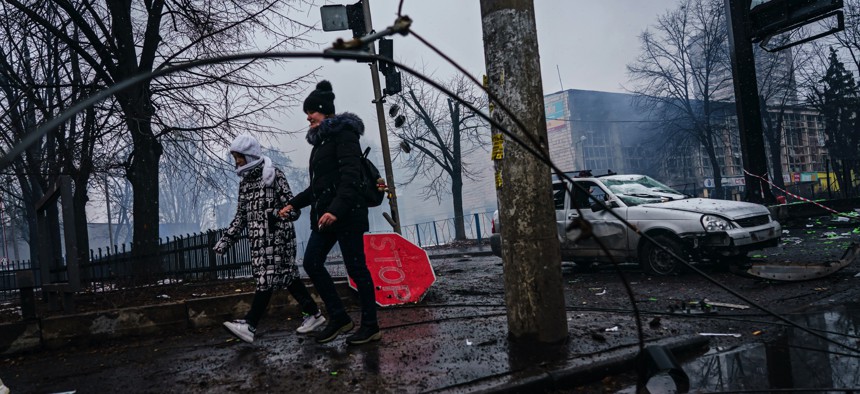
Damage caused by a Russian missile attack on the Kyiv TV tower in Kyiv, Ukraine, on March 2, 2022 MARCUS YAM / LOS ANGELES TIMES
Why Is Ukraine’s Internet Still Up? Perhaps Because the Invaders Need It
As well, eight years of effort to harden IT infrastructure may be paying off.
Updated: March 8, 11:31 a.m. ET.
In the days before Russia invaded Ukraine, many observers thought the oncoming tanks would be preceded by cyber attacks and a media blackout as Russian hackers took down the country’s communications.
Instead, Ukraine’s IT infrastructure has held up, allowing officials and citizens alike to dominate the global narrative with images of confused Russian soldiers and downed fighter jets.
“We have seen some internet outages, we have seen them try to impact the information and communication environment, not the least of which is striking, you know, television towers and that kind of thing,” a senior defense official told reporters last week.
But overall, the infrastructure remains operational. Why? Only the Russian leadership knows.
“They perhaps have found some value to keeping some public communications open for their own purposes, for their own decision-making processes, but that's just speculation,” the official said.
One prevailing theory among defense experts is that Russia is relying on the network to conduct its attack.
“Putting a communications network together, other than radios, is actually really hard,” said John Ferrari, a retired Army two-star general-turned-non-resident fellow at the American Enterprise Institute. Ferrari noted the U.S. Army’s own struggles to develop WIN-T, a joint expeditionary communications network.
He said Russian forces are likely navigating and communicating via cell phones and local internet connections.
“So I think they felt that they were going to go in there and ride that communication network. And you see it, right? You see the reports coming out of them using cell phones and local internet connections,” he said.
That’s likely why the cell towers are still standing, Ferrari said. “You can't take down the cell phone towers, because then you blind yourself.”
In some cases, where the Russian Army has struck cell towers, it took did just that: eliminated its ability to use its own secure communications, Bellingcat executive editor Christo Grozev tweeted on Monday.
“The idiots tried to use the Era cryptophones in Kharkiv, after destroying many 3G cell towers and also replacing others with stingrays. Era needs 3G/4G to communicate. The Russian army is equipped with secure phones that can't work in areas where the Russian army operates.”
Even if some of the convoys had satellite dishes to communicate independently of the towers, the nature of an invasion would make them almost impossible to use, said Mark Montgomery, a retired Navy rear admiral who is now an analyst at the Foundation for Defense of Democracies.
“You know how hard those are [to operate] once they move?” Montgomery said. “When you sit there fixed, it works perfectly okay. This works great. And then the minute you move it, you know, now you're like, ‘Holy crap, I can't get a synchronization.’ If there's crypto riding on it, it gets ten times harder.”
David Maxwell, a retired Army special forces colonel, said Russia may also be preserving the networks to eavesdrop on the Ukrainian military and civilian resistance.
Last week, SpaceX founder Elon Musk moved 47 Starlink telecommunications satellites and sent a truckload of ground terminals to Ukraine. But those terminals were immediately targeted and jammed, leading Musk to shift SpaceX priorities to “cyber defense & overcoming signal jamming,” he tweeted over the weekend.
Another reason the Ukrainian communications net may still be up: the country has been working to harden it against attack, with U.S. and European help, Ferrari and Montgomery said. These efforts began after Russia annexed Crimea, and accelerated after Russia targeted Ukraine’s power grid in 2016 and 2017. Since then, Montgomery said, “Ukrainians have done a much better job in their cyber protection efforts.”




